Naja facts for kids
Quick facts for kids Naja |
|
|---|---|
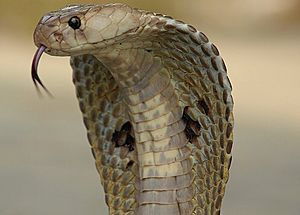 |
|
| Indian cobra (Naja naja), the genera species typica | |
| Scientific classification |
|
| Kingdom: | Animalia |
| Phylum: | Chordata |
| Class: | Reptilia |
| Order: | Squamata |
| Suborder: | Serpentes |
| Family: | Elapidae |
| Genus: | Naja Laurenti, 1768 |
| Type species | |
| Coluber naja Linnaeus, 1758
|
|
Naja is a group of venomous snakes often called "true cobras." These snakes are well-known for their ability to raise the front part of their body and spread their neck ribs to form a "hood." You can find different types of Naja cobras across Africa, Southwest Asia, South Asia, and Southeast Asia. While other snakes like the king cobra and rinkhals are also called "cobras," they are not part of the Naja group. They belong to their own separate snake families.
Not long ago, there were about 20 to 22 known species in the Naja group. However, scientists have studied them more closely. A big change happened in 2009, and now the Naja group includes 38 different species!
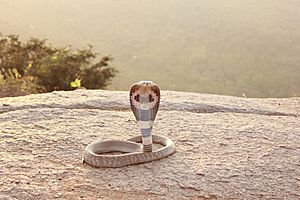
Contents
What's in a Name?
The name Naja comes from the ancient Sanskrit word nāga. This word simply means "snake." So, when you say Naja, you're basically saying "snake" in an old language!
How They Look
Naja snakes come in different sizes, but most of them are quite slender. Many species can grow to be about 1.84 m (6.0 ft) long. Some of the biggest cobras, like the forest cobra, can even reach lengths of around 3.1 m (10 ft). All Naja cobras have a special way of making themselves look bigger and scarier to anything that might try to harm them. They lift the front part of their body off the ground and flatten their neck into that famous "hood."
About Their Venom
| Rank | Species | LD50 SC |
|---|---|---|
| 1 | N. oxiana | 0.10 mg/kg |
| 2 | N. philippinensis | 0.14 mg/kg |
| 3 | N. samarensis | 0.21 mg/kg |
| 4 | N. melanoleuca | 0.225 mg/kg |
| 5 | N. siamensis | 0.25 mg/kg |
| 6 | N. atra | 0.28 mg/kg |
| 7 | N. naja | 0.29 mg/kg |
| 8 | N. nivea | 0.37 mg/kg |
| 9 | N. kaouthia | 0.47 mg/kg |
| 10 | N. sumatrana | 0.60 mg/kg |
All types of Naja cobras have venom that can be very dangerous to humans. Most of their venom is neurotoxic, meaning it affects the nervous system. This can cause muscles to become paralyzed. Many cobras also have venom that is cytotoxic, which can cause swelling and damage to body tissues. Some even have venom that affects the heart.
Spitting Cobras
Some Naja species are known as spitting cobras. They have a special way of using their venom. Instead of just biting, they can squirt their venom forward from their fangs. This is mostly a defense mechanism. They aim for the eyes of a threat. If the venom gets into someone's eyes, it can cause a lot of pain and even temporary or permanent blindness if it's not washed out right away.
Scientists think that cobras might have developed this "spitting" ability around the same time that early humans and chimpanzees started walking upright. This could be because early humans, being bipedal and using tools, might have seemed like a bigger threat, leading cobras to evolve a new way to defend themselves from a distance.
Most Potent Venom
The Caspian cobra (N. oxiana) from Central Asia is considered the most venomous Naja species. Its venom is extremely powerful. The Philippine cobra (N. philippinensis) also has very strong venom. Both of these species can cause serious problems very quickly after a bite, sometimes even in as little as 30 minutes.
Cobras are a big concern for health in the areas where they live because they cause many snake bites. Luckily, about 30% of cobra bites are "dry bites," which means no venom is injected. Even when venom is injected, medical treatment, especially with antivenom, can help many people recover. However, the type of cobra and how severe the bite is can change how well a person recovers. For example, the Caspian cobra's venom is very complex and can cause a lot of tissue damage, making it harder to treat.
Family Tree of Cobras
Scientists use special studies to understand how different cobra species are related to each other. They've found that some groups of snakes that used to be in their own separate families, like Boulengerina and Paranaja, are actually very closely related to Naja cobras. Because of this, these groups are now included within the Naja family.
Scientists have also divided the Naja genus into four main groups, or "subgenera," to help organize them:
- Naja (for Asian cobras)
- Boulengerina (for African forest, water, and burrowing cobras)
- Uraeus (for the Egyptian and Cape cobra group)
- Afronaja (for African spitting cobras)
This helps scientists understand the different types of cobras better and how they evolved.
Species of Naja Cobras
Here is a list of the different species within the Naja genus:
| Image | Species | Authority | Subsp.!bgcolor="#f0f0f0"|Common name | Geographic range | |
|---|---|---|---|---|---|
| N. anchietae | Bocage, 1879 | 0 | Anchieta's cobra (Angolan Cobra) | Angola, Botswana, Namibia, Zambia, eastern Zimbabwe | |
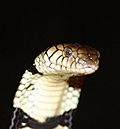 |
N. annulata | (Buchholz and Peters, 1876) | 1 | Banded water cobra | Cameroon, the Central African Republic, the Democratic Republic of the Congo (Zaire), the Republic of Congo, Equatorial Guinea, Gabon, Rwanda, and the province of Cabinda in Angola |
 |
N. annulifera | Peters, 1854 | 0 | Snouted cobra | Botswana, Malawi, Mozambique, South Africa, Swaziland, Zambia, Zimbabwe |
| †N. antiqua | Rage, 1976 | 0 | Moroccan cobra | Miocene-aged strata of Morocco | |
| N. arabica | Scortecci, 1932 | 0 | Arabian cobra | Oman, Saudi Arabia, Yemen | |
| N. ashei | Wüster and Broadley, 2007 | 0 | Ashe's spitting cobra (giant spitting cobra) | southern Ethiopia, Kenya, Somalia, eastern Uganda | |
 |
N. atra | Cantor, 1842 | 0 | Chinese cobra | southern China, northern Laos, Taiwan, northern Vietnam |
| N. christyi | (Boulenger, 1904) | 0 | Congo water cobra | the Democratic Republic of the Congo (Zaire), the Republic of Congo, and the province of Cabinda in Angola | |
| N. guineensis | Broadley, Trape, Chirio, Ineich &Wüster, 2018 | 0 | Black forest cobra | Ghana, Guinea, Guinea-Bissau, the Ivory Coast, Liberia, Sierra Leone, Togo | |
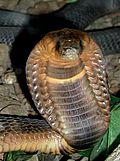 |
N. haje | Linnaeus, 1758 | 0 | Egyptian cobra | Tanzania, Kenya, Somalia, Ethiopia, Uganda, South Sudan, Sudan, Cameroon, Nigeria, Niger, Burkina Faso, Mali, Senegal, Mauritania, Morocco, Algeria, Tunisia, Libya, and Egypt |
| †N. iberica | Szyndlar, 1985 | Spanish cobra | Miocene-aged strata of Spain | ||
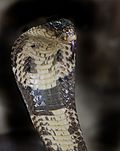 |
N. kaouthia | Lesson, 1831 | 0 | Monocled cobra | Bangladesh, Bhutan, Burma, Cambodia, southern China, eastern India, Laos, northwestern Malaysia, Nepal, Thailand, southeastern Tibet, Vietnam |
 |
N. katiensis | Angel, 1922 | 0 | Mali cobra (Katian spitting cobra) | Benin, Burkina Faso, Cameroon, Ghana, Guinea, the Ivory Coast, Mali, Gambia, Mauritania, Niger, Nigeria, Senegal, Togo |
| N. mandalayensis | Slowinski & Wüster, 2000 | 0 | Mandalay spitting cobra (Burmese spitting cobra) | Myanmar (Burma) | |
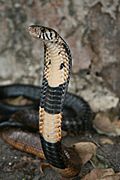 |
N. melanoleuca | Hallowell, 1857 | 0 | Forest cobra | Angola, Benin, Cameroon, the Central African Republic, the Republic of Congo, the Democratic Republic of the Congo (Zaire), Equatorial Guinea, Gabon, Nigeria |
 |
N. mossambica | Peters, 1854 | 0 | Mozambique spitting cobra | extreme southeastern Angola, Botswana, Malawi, Mozambique, Somalia, northeastern Namibia, South Africa, Swaziland, Tanzania (including Pemba Island), Zambia, Zimbabwe |
| N. multifasciata | Werner, 1902 | 0 | Many-banded cobra | Cameroon, Congo, the Democratic Republic of the Congo (Zaire), Gabon | |
 |
N. naja | (Linnaeus, 1758) | 0 | Indian cobra (spectacled cobra) | Bangladesh, Bhutan, India, Nepal, Pakistan, Sri Lanka |
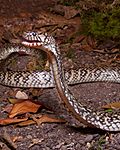 |
N. nana | Collet & Trape, 2020 | 0 | Dwarf water cobra | Democratic Republic of Congo |
 |
N. nigricincta | Bogert, 1940 | 1 | Zebra spitting cobra | Angola, Namibia, South Africa |
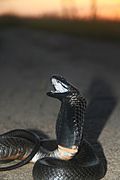 |
N. nigricollis | Reinhardt, 1843 | 0 | Black-necked spitting cobra | Angola, Benin, Burkina Faso, Burundi, Cameroon, the Central African Republic, Chad, the Democratic Republic of the Congo (Zaire) (except in the central region), Congo, Ethiopia, Gabon, Gambia, Ghana, Guinea-Bissau, Guinea, the Ivory Coast, Kenya, Liberia, Mali, Mauritania, Namibia, Niger, Nigeria, Rwanda, Senegal, Sierra Leone, Sudan, Tanzania, Somalia, Togo, Uganda, Zambia |
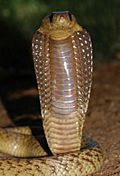 |
N. nivea | (Linnaeus, 1758) | 0 | Cape cobra (yellow cobra) | Botswana, Lesotho, Namibia, South Africa |
| N. nubiae | Wüster & Broadley, 2003 | 0 | Nubian spitting cobra | Chad, Egypt, Eritrea, Niger, Sudan | |
 |
N. oxiana | (Eichwald, 1831) | 0 | Caspian cobra | Afghanistan, northwestern India, Iran, Kyrgyzstan, Pakistan, Tajikistan, Turkmenistan, Uzbekistan |
 |
N. pallida | Boulenger, 1896 | 0 | Red spitting cobra | Djibouti, Ethiopia, Kenya, Somalia, Tanzania |
| N. peroescobari | Ceríaco, Marques, Schmitz & Bauer, 2017 | 0 | São Tomé forest cobra, cobra preta | São Tomé and Príncipe (São Tomé) | |
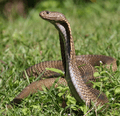 |
N. philippinensis | Taylor, 1922 | 0 | Philippine cobra | the Philippines (Luzon, Mindoro) |
| †N. romani | Hofstetter, 1939 | 0 | †European cobra | Miocene-aged strata of France, Germany, Austria, Romania, and Ukraine | |
| N. sagittifera | Wall, 1913 | 0 | Andaman cobra | India (the Andaman Islands) | |
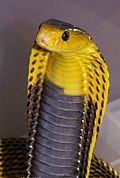 |
N. samarensis | Peters, 1861 | 0 | Samar cobra | the Philippines (Mindanao, Bohol, Leyte, Samar, Camiguin) |
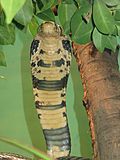 |
N. savannula | Broadley, Trape, Chirio & Wüster, 2018 | 0 | West African banded cobra | Benin, Burkina Faso, Cameroon, Chad, Gambia, Ghana, Guinea, the Ivory Coast, Mali, Niger, Nigeria, Senegal, Togo |
| N. senegalensis | Trape, Chirio & Wüster, 2009 | 0 | Senegalese cobra | Benin, Burkina Faso, Ghana, Guinea, Mali, Niger, Nigeria, Senegal | |
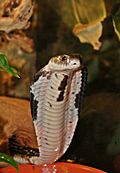 |
N. siamensis | Laurenti, 1768 | 0 | Indochinese spitting cobra | Cambodia, Laos, Thailand, Vietnam |
 |
N. sputatrix | F. Boie, 1827 | 0 | Javan spitting cobra | Indonesia (Java, the Lesser Sunda Islands, East Timor) |
| N. subfulva | Laurent, 1955 | 0 | Brown forest cobra | Angola, Burundi, Cameroon, the Central African Republic, Chad, the Republic of Congo, the Democratic Republic of the Congo (Zaire), Ethiopia, Kenya, Malawi, Mozambique, Nigeria, Rwanda, Somalia, South Africa, South Sudan, Tanzania, Uganda, Zambia, Zimbabwe | |
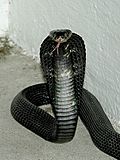 |
N. sumatrana | Müller, 1887 | 0 | Equatorial spitting cobra | Brunei, Indonesia (Sumatra, Borneo, Bangka, Belitung), Malaysia, the Philippines (Palawan), southern Thailand, Singapore |
- Not including the nominate subspecies
† Extinct
T Type species
See also
 In Spanish: Naja para niños
In Spanish: Naja para niños


